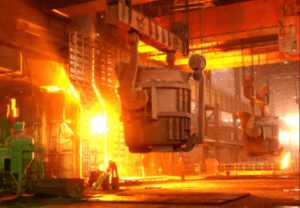BERLIN / BEIJING / BRUSSELS — China’s HBIS Group has begun exporting what it markets as lower-emission steel to the European Union, a watershed moment that tests Europe’s carbon border regime and intensifies pressure on Germany’s industry to decarbonize at speed. HBIS struck an order exceeding 10,000 tons for an Italian buyer—described as hydrogen-assisted direct-reduced iron (DRI) steel with roughly 50% lower embedded CO₂ than blast-furnace metal. Market reports suggest the traded volume could be as high as 20,000 tons.
Europe’s Carbon Wall Is About to Start Billing
The EU’s Carbon Border Adjustment Mechanism (CBAM) moves from reporting to payment on embedded emissions on Jan. 1, 2026, aligning importers’ carbon costs with those faced by EU mills under the Emissions Trading System. Brussels last month urged importers to apply as authorized CBAM declarants ahead of the “definitive period.”
At today’s EU carbon price (EUA Sep-25 futures near €75/t CO₂), the illustrative CBAM charge per tonne of hot metal pencils out starkly:
- Conventional BF-BOF steel (~2.3 tCO₂/t): ≈ €170–€180/t
- Gas-DRI/EAF (~1.4 tCO₂/t): ≈ €100–€110/t
- Scrap-EAF (~0.7 tCO₂/t): ≈ €50–€55/t
- HBIS claim (≈ 50% of BF-BOF): ≈ €85–€90/t
(Emissions intensities from international benchmarking; price from ICE EUA futures. Figures are order-of-magnitude and depend on verified footprints and free-allocation adjustments.)
China Is Rewriting Its Own Rulebook
Beijing is also tightening climate policy in heavy industry. In March–April 2025, China formally expanded its national carbon market (ETS) beyond the power sector to steel, cement and aluminum, covering roughly 60% of national emissions, with first compliance on 2024 data and absolute caps slated from 2027. Early phases feature generous free allocation, muting near-term costs but signaling direction.
Germany’s Transition: Push, Pull—and Some Stumbles
HBIS’s shipment lands as German producers juggle high investment needs, soft demand and policy flux. ArcelorMittal walked away from €1.3 billion in aid for DRI projects in Bremen and Eisenhüttenstadt, citing economics; Thyssenkrupp is pressing Brussels to slow the phase-out of free EU ETS allowances; Salzgitter is building its SALCOS DRI-EAF line but has delayed later phases to 2028/29.
A further headwind: the United States has raised its steel tariff to 50%, complicating export strategies and revenue for European mills already facing weak margins.
The Competitive Math: Who Has the Cost Edge?
1) Embedded-Carbon Costs (CBAM)
From 2026, imports with higher verified CO₂ will pay more at the EU border. If HBIS’s Italian lots validate at ≈50% of BF-BOF, their CBAM bill could undercut conventional imports by €80–€90/t, tightening spreads with Europe’s nascent low-carbon output. (Outcome hinges on audit rules, system boundaries, gas vs. hydrogen shares, and electricity mix used to make hydrogen.)
2) Technology Pathways
- EU Today: A patchwork—legacy BF-BOF, expanding scrap-EAF, and early gas/H₂-DRI pilots. Emissions intensity varies widely by route and grid factor.
- China’s Offer: DRI-EAF with natural gas + hydrogen. If hydrogen is fossil-based and power carbon-intensive, gains shrink; “green H₂” lifts capex and opex but slashes CO₂. Verification is pivotal.
3) Policy Trajectory
- EU: CBAM bills start 2026; free allowances decline in lockstep, pushing mills toward DRI-EAF and high-grade scrap.
- China: ETS expansion now covers steel, with absolute caps from 2027, plus new renewable-use mandates for steel and other sectors—nudging costs and power mixes lower-carbon over time.
4) Trade Frictions
A 50% U.S. steel tariff narrows outlets for EU exports, making the EU market—protected but carbon-priced—the main arena for “green” competition. Retaliatory steps and broader tariff battles add uncertainty.
What to Watch Next
- Verification & Methodology: The CBAM emissions accounting rules and on-site audits will decide whether “hydrogen-DRI” claims translate into materially lower levies at EU borders.
- Hydrogen Sourcing: The share of green H₂ vs. natural gas in Chinese DRI lines will determine real-world footprints—and price. (EU auditors will scrutinize upstream electricity.)
- German Build-out Pace: Whether Thyssenkrupp secures policy relief, Salzgitter holds its 2027 first-phase start, and ArcelorMittal revisits its German plans will shape domestic supply of low-CO‚ÇÇ steel.
- Carbon Price Path: With EUAs near €75, every €10/t swing shifts CBAM by €7–€23/t depending on route—enough to flip tenders at thin margins.
Bottom line: HBIS’s first “green” cargo into Italy shows how fast climate policy is redrawing the steel map. If Europe’s mills scale hydrogen-DRI and scrap-EAF on time—and Brussels keeps verification tight—they can hold the home field. If not, Chinese suppliers adapting to CBAM may seize a surprising green premium in Europe’s backyard. (zai)
Photo: HBIS Group

